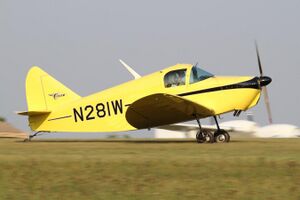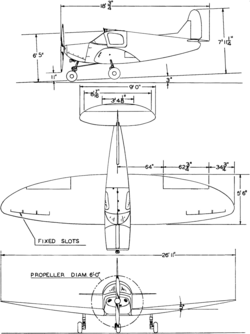Engineering:Culver Cadet
| Cadet / PQ-8 | |
|---|---|

| |
| Culver LCA Cadet | |
| Role | Two-seat light monoplane |
| National origin | United States |
| Manufacturer | Culver Aircraft Company |
| Designer | Albert Mooney |
| First flight | 1939 |
| Number built | 600+ |
| Variants | Culver PQ-14 Cadet |
The Culver Cadet is an American two-seat light monoplane aircraft, also as a radio-controlled drone, produced by the Culver Aircraft Company.
Design and development
The aircraft designer Al Mooney developed an improved version of the Culver Dart, to provide improved performance with a smaller engine. Originally designated the Culver Model L, the prototype first flew on 2 December 1939. The aircraft was named the Culver Cadet. Although similar to the previous Dart, the Cadet had a semi-monocoque fuselage instead of welded-steel-tube, and a retractable tailwheel undercarriage. The first variant (the Cadet LCA) was powered by a 75 hp (56 kW) Continental A75-8 four-cylinder horizontally-opposed piston engine.
The 1941 version was designated the Cadet LFA, introducing a number of refinements and more equipment, and was fitted with a 90 hp (67 kW) Franklin engine. Production was brought to an end after the United States entered World War II in December 1941, but the Cadet had found export orders, including to Uruguay, and had a new military role.
The Cadet was one of six models that Al Mooney designed during his eight years at Culver. He would leave to found Mooney Aircraft.
Operational history
In 1940, the Cadet LCA was selected by the United States Army Air Corps as being suitable for use as a radio-controlled target. The first aircraft was designated the Culver A-8 (later the XPQ-8) and was based on the Cadet LFA, but had fixed tricycle landing gear. After successful tests, a production order for 200 was placed, and designated the PQ-8. Later, another 200 were ordered with a more powerful engine as the PQ-8A. In late 1941, the United States Navy acquired a PQ-8A for evaluation, and then ordered 200 in 1941 as the TDC-2. An enlarged and improved version was later built as the Culver PQ-14.
Several Cadets, with both military and civilian origins, are still (2012) airworthy in the United States, and some are preserved in airworthy condition by museums.
Variants
- Cadet LCA
- Initial production version powered by a 75 hp (56 kW) Continental A75-8.
- Cadet LFA
- Improved variant with an 80 hp (60 kW) Franklin 4AC-176-F3, Franklin 4AC-176-D2, or Franklin 4AC-176-D3 engine, and a full electrical system and engine starter.
- Cadet LFA-90
- Limited edition variant with a 90 hp (67 kW) Franklin 4AC-199-E3 engine.
- LAR (Army A-8)
- Initial designation of military radio-controlled drone version, later redesignated PQ-8.
- LAR-90 (Army PQ-8)
- Initial production military drone version, 200 built.
- PQ-8A
- PQ-8 powered by a 125 hp (93 kW) Lycoming O-290 engine, redesignated Q-8A in 1948, 200 built.
- Q-8A
- PQ-8A redesignated in 1948.[citation needed]
- TDC-1
- One PQ-8 for evaluation by the United States Navy.
- TDC-2
- Production version of the PQ-8A for the Navy, 200 built.
- Helton Lark 95
- Development of Cadet by Helton Aircraft Corporation of Mesa, Arizona. Powered by 90 horsepower (67 kW) Continental C90-16F engine. FAA type approved in September 1966. 15 Lark 95s delivered in 1966.[1] Helton reported as out of business in 1971.[2]
- Helton Lark 95A
- Modified Lark 96, with 2 feet (0.61 m) longer fuselage and revised tail surfaces.[1]
- Aero Systems Cadet STF
- Plans-built "optimized" Cadet design, offered by Aero Systems of La Mesa, California, United States in 2010. The plans call for a wood and steel structure, with a 100 hp (75 kW) Continental O-200 powerplant, producing a cruise speed of 135 mph (217 km/h).[3]
Operators
 United States
United States
- United States Army Air Corps
- United States Navy
Surviving aircraft
- On display at the Historical Aircraft Squadron Museum in Carroll, Ohio. It is on loan from the Ohio Historical Society, who acquired it from the Ohio History of Flight Museum in 2000.[4]
- 133 – LCA on display at the Chico Air Museum in Chico, California.[5][6]
- 236 – LCA on display at the Western Antique Aeroplane & Automobile Museum in Hood River, Oregon.[7][8]
- 269 – LFA on display at the Golden Age Air Museum in Bethel, Pennsylvania.[9][10]
- 274 – LFA on display at the Champaign Aviation Museum in Urbana, Ohio.[11]
- 330 – LFA-90 on display at the Vintage Flying Museum in Fort Worth, Texas.[12][13]
- 380 – LCA on display at the Historic Aircraft Restoration Museum in Maryland Heights, Missouri.[14][15]
- 443 – LCA on display at the Airpower Museum in Ottumwa, Iowa.[16][17]
Specifications (Cadet LFA)
Data from U.S. Civil Aircraft Vol. 8[18]
General characteristics
- Crew: two
- Length: 17 ft 8 in (5.38 m)
- Wingspan: 27 ft 0 in (8.23 m)
- Height: 5 ft 6 in (1.68 m)
- Wing area: 120 sq ft (11 m2)
- Airfoil: NACA3414 at wing root, NACA 3408 at tip
- Empty weight: 806 lb (366 kg)
- Gross weight: 1,305 lb (592 kg)
- Fuel capacity: 20 US gal (17 imp gal; 76 L)
- Powerplant: 1 × Franklin 4AC-176-F3 air-cooled flat-four piston, 80 hp (60 kW)
Performance
- Maximum speed: 142 mph (229 km/h, 123 kn) at 3,000 ft (910 m)
- Cruise speed: 130 mph (210 km/h, 110 kn) at 7,000 ft (2,100 m) (75% power)
- Range: 500 mi (800 km, 430 nmi)
- Service ceiling: 17,000 ft (5,200 m)
- Rate of climb: 800 ft/min (4.1 m/s) at sea level
See also
Related development
Aircraft of comparable role, configuration and era
References
Notes
- ↑ 1.0 1.1 Taylor 1967, pp. 273–274.
- ↑ Taylor 1971, p. 320.
- ↑ Bayerl, Robby; Martin Berkemeier; et al: World Directory of Leisure Aviation 2011–12, page 90. WDLA UK, Lancaster UK, 2011. ISSN 1368-485X
- ↑ Poling, Lesley (25 August 2015). "Where is it now? Collections from the former History of Flight Museum". http://www.ohiohistory.org/learn/collections/history/history-blog/2015/august-2015/history-of-flight-museum.
- ↑ "ANNUAL REPORT 2017". 15 January 2018. http://www.chicoairmuseum.org/Website_CHICO_AIR_MUSEUM_YEARLY_REPORT_2017_Website.pdf.
- ↑ "FAA REGISTRY [N29264"]. U.S. Department of Transportation. http://registry.faa.gov/aircraftinquiry/NNum_Results.aspx?NNumbertxt=N29264.[yes|permanent dead link|dead link}}]
- ↑ "Culver Cadet LCA". Western Antique Aeroplane & Automobile Museum (WAAAM). http://www.waaamuseum.org/collections/airplanes/211-Culver-Cadet-LCA.
- ↑ "FAA REGISTRY [N34785"]. U.S. Department of Transportation. http://registry.faa.gov/aircraftinquiry/NNum_Results.aspx?NNumbertxt=34785.[yes|permanent dead link|dead link}}]
- ↑ "MUSEUM COLLECTION". http://www.goldenageair.org/collection.htm.
- ↑ "FAA REGISTRY [N34856"]. U.S. Department of Transportation. http://registry.faa.gov/aircraftinquiry/NNum_Results.aspx?NNumbertxt=34856.[yes|permanent dead link|dead link}}]
- ↑ "FAA REGISTRY [N34864"]. U.S. Department of Transportation. http://registry.faa.gov/aircraftinquiry/NNum_Results.aspx?NNumbertxt=34864.
- ↑ "Culver Cadet LFA". http://www.vintageflyingmuseum.org/on-display/culver-cadet.
- ↑ "FAA REGISTRY [N37819"]. U.S. Department of Transportation. http://registry.faa.gov/aircraftinquiry/NNum_Results.aspx?NNumbertxt=37819.[yes|permanent dead link|dead link}}]
- ↑ "Museum Hangar 3". http://historicaircraftrestorationmuseum.org/museumhangar3.html.
- ↑ "FAA REGISTRY [N41621"]. U.S. Department of Transportation. http://registry.faa.gov/aircraftinquiry/NNum_Results.aspx?NNumbertxt=41621.[yes|permanent dead link|dead link}}]
- ↑ "1942 Culver LCA(LFA)". http://www.antiqueairfield.com/apm/collection/CulverLCA.html.
- ↑ "FAA REGISTRY [N41725"]. U.S. Department of Transportation. http://registry.faa.gov/aircraftinquiry/NNum_Results.aspx?NNumbertxt=41725.[yes|permanent dead link|dead link}}]
- ↑ Jutpner 1980, p. 117
Bibliography
- The Illustrated Encyclopedia of Aircraft (Part Work 1982–1985). London: Orbis Publishing, 1985.
- Juptner, Joseph J. U.S. Civil Aircraft Vol. 8 (ATC 701 – ATC 800). Fallbrook, California, US: Aero Publishers Inc., 1980. ISBN 0-8168-9178-8.
- Mondey, David. American Aircraft of World War II (Hamlyn Concise Guide). London: Bounty Books, 2006. ISBN:978-0-7537-1461-4.
- Mormillo, Frank B. "Defenceless Warrior: Culver's PQ-14 Drone." Air Enthusiast, Issue 93, May/June 2001.
- Simpson, R.W. Airlife's General Aviation. Shrewsbury, UK: Airlife Publications. 1991. ISBN:1-85310-194-X.
- Taylor, John W. R. Jane's All The World's Aircraft 1967–68. London: Sampson Low, Marston & Company, 1968.
- Taylor, John W. R. Jane's All The World's Aircraft 1971–72. London: Sampson Low, Marston & Company, 1971. ISBN:0-354-00094-2.
External links
- Culver A-8/PQ-8/TDC Cadet
- Culver TD2C-1 'Cadet' – Aviation Enthusiast Corner
- Al Mooney designs
- High resolution panoramic image of a Culver Cadet
- www.culvercadet.com
 |




